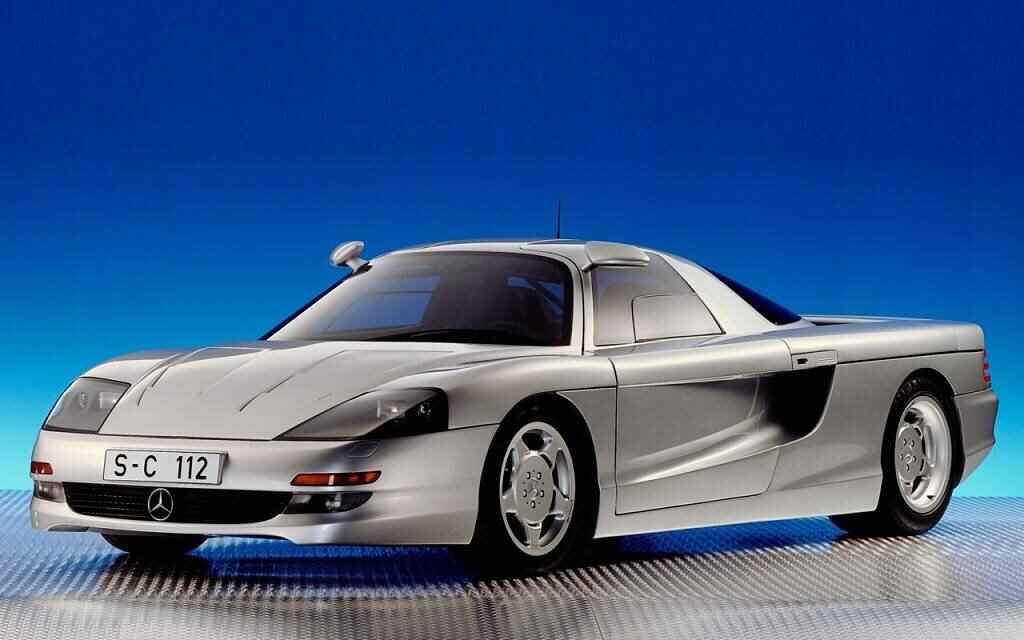At the 1991 Frankfurt Motor Show, Mercedes-Benz presented the future of supercars, combining performance and technology at all levels. The C112 promised to be more efficient, more reliable and to hold the road better than the competition. Customers got fired up but the future didn’t turn out as planned.
Development of the W140 series S-Class began in 1981. Everything was going well until BMW launched its new E32 7 Series in 1986 and fitted it with a V12 in 1987. Obviously, Mercedes had to replicate and show these impediments to dominate in circles who were the bosses. The W140 will therefore have a V12, the first of the brand mounted in a road model, the M120 (an engine that will be found later in the Pagani Zonda).
Aero and dynamic
And what better way to mark the spirits than to present a concept of supercar drawn around this engine? Especially since Mercedes has a rich past from which it can draw, in particular the C111 concepts of the 60s and 70s. Work began in 1988 at the advanced design studio (DAS), under the direction of Bruno Sacco. Heritage obliges (300 SL and C111), the butterfly doors are essential. They use large assist cylinders to deploy them at the touch of a button, and are designed to be folded for access to the interior in the event of a rollover.
Around them, the designers Harald Leschke and Joseph Gallitzendörfer choose efficient lines, inspired by the competition (like the Mercedes C11 endurance for example). The body is aluminum with Kevlar bumpers. Finally, after spending quite a bit of time in the wind tunnel, the C112 will offer a Cd of only 0.30 and will benefit from active aerodynamic elements. the spoiler front, integrated into the bumper, can be lowered depending on the speed. The rear wing remains folded at high speed to reduce drag and raises (thanks to hydraulic cylinders) to generate downforce in curves or serve as an airbrake when needed (by tilting up to 45 degrees). Everything is managed by computer. Wide diffusers are integrated into the rear bumper. Only three air intakes are visible: one at the front (radiator and front brake cooling) and two on the sides (engine air supply, oil cooler and rear brake cooling).
Photo: Mercedes-Benz
The design of the chassis, produced under the technical direction of Karl Hoehl, also has its origins in the competition. It is a riveted and bonded aluminum monocoque type with a steel roll cage. It is designed from the outset to pass collision standards. The 17-inch wheels come from Speedline while Brembo provides the brakes. However, the C112 has no trunk and no spare wheel.
The computer fairy
The 6-litre M120 V12 sits in the middle rear position. It generates 402 horsepower (for comparison, a 1991 Ferrari Testarossa produced 380 horsepower) and is mated to a 6-speed manual gearbox specifically designed for the C112.
But surprisingly, it’s not the main course of the car. No, Mercedes wants to demonstrate its technical superiority and installs a slew of innovative technologies… for the time. The most important is the ABC (Active Body Control) suspension which uses electronically controlled hydraulic dampers to control body roll, alter ride height and adjust handling characteristics (from understeer to oversteer as desired). of the driver).

Photo: Mercedes-Benz
The C112 is the first Mercedes to benefit from it (the first production model to receive it will be the CL Class C215 in 1999). Another curiosity, the steering to the rear wheels but only to improve stability at high speed and not to facilitate maneuvers (Mercedes calls it Cybernetic Steering). There is also ABS, ASR (traction control), a tire pressure monitor and cruise control with radar. The integration of all these systems with each other will keep engineers awake for many nights.
Comfort is not to be outdone since the interior is entirely upholstered in leather, there is power steering, heated seats, air conditioning, electric windows… and a Blaupunkt Mexico radio cassette player. We are far from the destitution of some others supercars…

Photo: Mercedes-Benz
Once the plans were finalized, the construction was carried out by the Italian coachbuilder Coggiola, in Turin. The final product weighs 1,571 kilos (distribution of 42% on the front and 58% on the rear), which does not prevent it from achieving 0 to 100 km/h in 4.9 seconds and reaching a top speed of 309 km/h… on a simulator only.
miss the boat
As expected, the C112 made its impact at the Frankfurt Motor Show in September 1991. The concept was appreciated for its performance, sophistication, safety features and comfort. It appears that it could quickly be approved all over the world (thanks to the M120, it can pass Swiss noise standards or American pollution standards without difficulty).

Photo: Mercedes-Benz
The story repeats itself. As with the C111 II in 1970, Mercedes receives checks from enthusiastic buyers… no less than 700! And not just deposits, some checks went up to 1.5 million German marks (about two million Canadian dollars today). In front of the microphones, the new boss of the Daimler-Benz automotive division, Jürgen Hubbert, says that various options are being evaluated for small-series production. The Swiss workshops of Peter Sauber, which supplies the C11 Group C to Mercedes, could be used. But the C112 was developed under the direction of Hubbert’s predecessor, Werner Niefer. Hubbert has other ambitions for the brand and, despite the golden bridges of the clientele, decides not to go further. And like the C111 II, the C112 project fades away silently…
But what a missed opportunity! A few months later, in May 1992, McLaren presented its legendary F1 in Monaco. Its 6.1 liter V12 supplied by BMW was going to make everyone agree! So who are the bosses?
